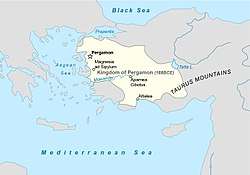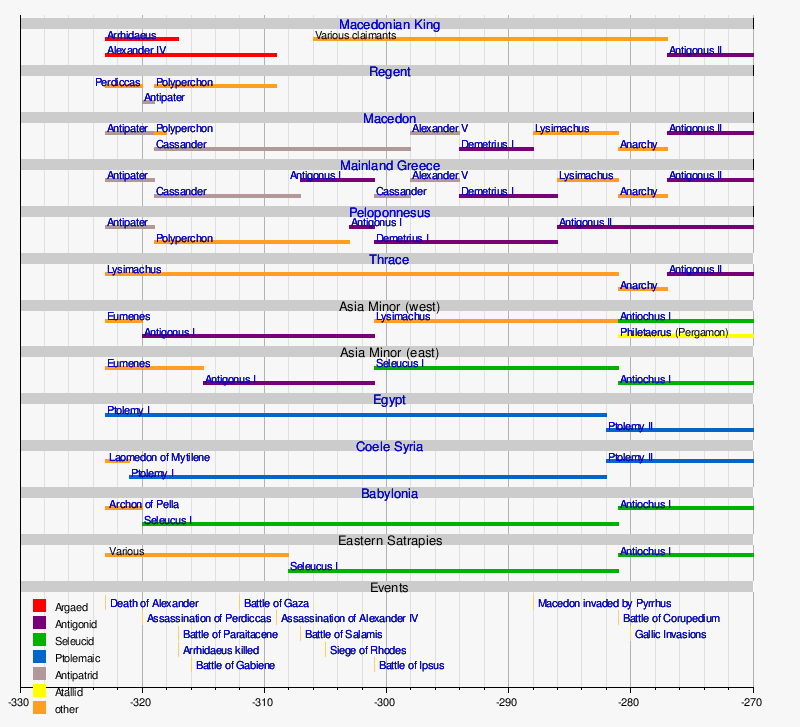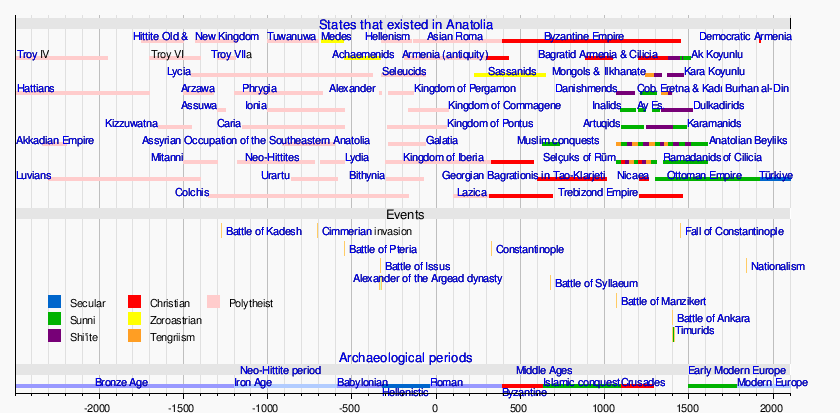Attalid dynasty
| Kingdom of Pergamon | |||||||||
|---|---|---|---|---|---|---|---|---|---|
| 282 BC–133 BC | |||||||||
|
Coat of arms
| |||||||||
 | |||||||||
| Capital | Pergamon | ||||||||
| Common languages |
Greek Lycian, Carian, Lydian | ||||||||
| Government | Monarchy | ||||||||
| King | |||||||||
• 282–263 BC | Philetaerus | ||||||||
• 263–241 BC | Eumenes I | ||||||||
• 241–197 BC | Attalus I | ||||||||
• 197–159 BC | Eumenes II | ||||||||
• 160–138 BC | Attalus II | ||||||||
• 138–133 BC | Attalus III | ||||||||
• 133–129 BC | Eumenes III | ||||||||
| Historical era | Hellenistic period | ||||||||
| 282 BC | |||||||||
| 133 BC | |||||||||
| |||||||||
The Attalid dynasty (/ˈætəlɪd/; Greek: Δυναστεία των Ατταλιδών Dynasteía ton Attalidón) was a Hellenistic dynasty that ruled the city of Pergamon in Asia Minor after the death of Lysimachus, a general of Alexander the Great.
The kingdom was a rump state that had been left after the collapse of the Lysimachian Empire. One of Lysimachus' lieutenants, Philetaerus, took control of the city in 282 BC. The later Attalids were descended from his father and expanded the city into a kingdom.
History
In 282 BC, Philetaerus deserted Lysimachus, offering himself and the important fortress of Pergamon, along with its treasury, to Seleucus I Nicator, who defeated and killed Lysimachus at the Battle of Corupedium in 281 BC. Seleucus was killed a few months later.[1] Philetaerus, especially after the death of Seleucus, enjoyed considerable autonomy despite being nominally under the Seleucids. He acquired considerable wealth because Pergamon had been the treasure-hold of Lysimachus[1] and extended his power and influence beyond Pergamon. He contributed troops, money and food to the city of Cyzicus, in Mysia, for its defence against the invading Gauls, thus gaining prestige and goodwill for him and his family.[2] He reigned for forty years and built the temple of Demeter on the acropolis, the temple of Athena (Pergamon's patron deity), and Pergamon's first palace. He added considerably to the city's fortifications.[3]
Eumenes I succeeded in 263 BC. He rebelled and defeated the Seleucid king Antiochus I Soter near the Lydian capital of Sardis in 261 BC. He freed Pergamon, and greatly increased its territories. He established garrisons, such as Philetaireia, in the north at the foot of Mount Ida, which was named after his adoptive father, and Attaleia, in the east, to the northeast of Thyatira near the sources of the river Lycus, which was named after his grandfather. He also extended his control to the south of the river Caïcus, reaching the Gulf of Cyme. He minted coins with the portrait of Philetaerus, who was still depicting the Seleucid king Seleucus I Nicator in his coins.
Pausanias wrote that the greatest achievement of Attalus I (reigned 241–197 BC) was his defeat of the Gauls,[4] by which he meant the Galatians, Celts who had migrated to central Asia Minor and established themselves as a major military power. Several years later the Galatians attacked Pergamon with the help of Antiochus Hierax, who rebelled against his brother Seleucus II Callinicus, the king of the Seleucid Empire and wanted to seize Anatolia and make it his independent kingdom. Attalus defeated the Gauls and Antiochus in the battle of Aphrodisium and in a second battle in the east. He then fought Antiochus alone in a battle near Sardis and in the Battle of the Harpasus in Caria in 229 BC. Attalus won a decisive battle and Antiochus left to start a campaign in Mesopotamia.[5] He gained control over Seleucid territories in Asia Minor north of the Taurus Mountains. He repulsed several attempts by Seleucus III Ceraunus, who had succeeded Seleucus II, to recover the lost territory.
In 223 Seleucus III crossed the Taurus, but was assassinated. Achaeus assumed control of the army. Antiochus III the Great then made him governor of Seleucid territories north of the Taurus. Within two years he recovered the lost territories and forced Attalus within the walls of Pergamon. However, he was accused of intending to revolt and to protect himself he proclaimed himself king.[6][7][8]
In 218 BC Achaeus undertook an expedition to Selge, south of the Taurus. Attalus recaptured his former territories with the help of some Thracian Gauls. Achaeus returned from his victorious campaign in 217 BC and hostilities between the two resumed. Attalus made an alliance with Antiochus III, who besieged Achaeus in Sardis in 214 BC. Antiochus captured the city and put Achaeus to death in the next year. Attalus regained control over his territories.[6][9]
The Attalids became allies of Rome during the First Macedonian War (214–205 BC)[10][11] and supported Rome in subsequent wars. Attalus I, who had helped the Romans in the first war, also provided them with assistance in the Second Macedonian War (200–197 BC).[12][13]
Eumenes II (reigned 197–159 BC)[14] supported Rome in the Roman–Seleucid War (192–188 BC)[15][16] and in the Third Macedonian War (171–168 BC) [17] In 188 BC, after the war against the Seleucids, the Romans seized the possessions of the defeated Antiochus III the Great in Asia Minor and gave Mysia, Lydia, Phrygia, and Pamphylia to the kingdom of Pergamon and Caria Lycia and Pisidia, in the southwestern corner of Asia Minor, to Rhodes, another Roman ally. Later the Romans gave these possessions of Rhodes to Pergamon.
Before he became king, Attalus II was a military commander. In 190 BC he took part in the Battle of Magnesia, which was the final victory of the Romans in the war against the Seleucids. In 189 BC he led the Pergamene troops which flanked the Roman Army under Gnaeus Manlius Vulso in the Galatian War. In 182-179 BC, he was at war with Pharnaces I of Pontus. He won victories and gained some territory. He acceded to the throne in 159 BC. In 156-54 BC he made war against Prusias II of Bithynia with the help of the Romans. In 154 BC he was also assisted by Ariarathes V of Cappadocia, who provided troops led by his son Demetrius. Attalus expanded his kingdom and founded the cities of Philadelphia and Attalia. In 152 BC the two kings and Rome helped the pretender Alexander Balas to seize the Seleucid throne from Demetrius I Soter. In 149 BC, Attalus helped Nicomedes II Epiphanes to seize the Bithynian throne from his father Prusias II.[18]
The last Attalid king, Attalus III died without issue and bequeathed the kingdom to the Roman Republic in 133 BC.[19] The Romans were reluctant to take on territory in Asia Minor and did not take charge of the kingdom. Aristonicus, claimed to be the illegitimate son of Attalus III, assumed the dynastic name of Eumenes III, claimed the throne, instigated a rebellion and in 132 BC "occupied Asia, which had been bequested to the Roman people and was supposed to be free."[20] In 131 BC Rome sent an army against him which was defeated. The Romans defeated Eumemes III in 129 BC. They annexed the former kingdom of Pergamon, which became the Roman province of Asia.
In the interior of the Pergamon Altar there is a frieze depicting the life of Telephus, son of Herakles. The ruling dynasty associated Telephus with its city and used him to claim descent from the Olympians. Pergamon, having entered the Greek world much later than its counterparts to the west, could not boast the same divine heritage as older city-states and so had to cultivate its place in Greek mythology retroactively.
Dynasty of Pergamon
- Philetaerus (282–263 BC)
- Eumenes I (263–241 BC)
- Attalus I Soter (241–197 BC)
- Eumenes II (197–159 BC)
- Attalus II Philadelphus (160–138 BC)
- Attalus III (138–133 BC)
- Eumenes III Aristonicus (pretender, 133–129 BC)
Genealogy
| Attalus | Boa | ||||||||||||||||||||||||||||||||||||||||||||||||||
| Philetaerus | Eumenes | Satyra | Attalus | ||||||||||||||||||||||||||||||||||||||||||||||||
| Eumenes I | Philetaerus (?) | Attalus | Antiochis | Eumenes (?) | |||||||||||||||||||||||||||||||||||||||||||||||
| Attalus I | Apollonis | ||||||||||||||||||||||||||||||||||||||||||||||||||
| Stratonice | Eumenes II | (?) | Attalus II | Philetaerus | Athenaeus | ||||||||||||||||||||||||||||||||||||||||||||||
| Attalus III | Eumenes III | ||||||||||||||||||||||||||||||||||||||||||||||||||
Namesakes
- Attalea in Lydia, Roman city, former diocese and present Latin Catholic titular bishopric; now Yanantepe
- Attalea in Pamphylia, Roman city, former diocese and present Latin Catholic titular bishopric; now Antalya
See also
Notes
- 1 2 Strabo, Geography, 13.4.1
- ↑ Hansen, E. V., The Attalids of Pergamon, pp. 18-19
- ↑ Hansen, E. V., The Attalids of Pergamon, pp. 17-18
- ↑ Pausanias, Description of Greece, 1.8.1
- ↑ Hansen, E. V., The Attalids of Pergamon, pp. 34-35
- 1 2 Hansen, E. V., The Attalids of Pergamon, pp. 36-39
- ↑ Green, P., "The Road to Sellasia". Alexander to Actium, pp. 264-65
- ↑ Polybius, Histories, 4.48
- ↑ Polybius, Histories, 5.77 , 7.15
- ↑ Livy, The History of Rome, 26.24
- ↑ Hansen, E. V., The Attalids of Pergamon, p. 47
- ↑ Pausanias, Description of Greece, 10.15.3
- ↑ Hansen, E. V., The Attalids of Pergamon, p. 57
- ↑ Attalus, Eumenes II Soter
- ↑ Appian, The syrian Wars, 31
- ↑ Livy, The History of Rome, Books 33-35
- ↑ Livy, Periochae, 42.3; The History of Rome, Books 42-45
- ↑ Livius, Attalus II Philadelphus
- ↑ Shipley, The Greek World After Alexander, 323-30 B.C, pp. 318-319.
- ↑ Livy, Periochae, 58.3
Bibliography
- Allen, R. E., The Attalid kingdom, a constitutional history, Oxford University Press, 1983; ISBN 978-0198148456
- Austin, M.M., The Hellenistic World from Alexander to the Roman Conquest:A Selection of Ancient Sources in Translation, "The Attalids of Pergamum", Cambridge University Press, 2006; ISBN 978-0521535618
- Dignas B., "Rituals and the Construction of Identity in Attalid Pergamon" in Dignas B, Smith RRR, (eds), Historical and religious memory in the ancient world, Oxford University Press, 2012; ISBN 978-0199572069
- Hansen, E. V., The Attalids of Pergamon (Study in Classical Philology). Cornell University Press, 2nd revised edition, 1972; ; ISBN 978-0801406157. First edition, 1947; ASIN: B000MRG0T6
- Kosmetatou, E., "The Attalids of Pergamon", in Erskine, A., A Companion to the Hellenistic World, Blackwell, new edition, 2005; ISBN 978-1405132787
- Welles, C. B., (ed.), Royal correspondence in the Hellenistic period: A study in Greek epigraphy, Ares Publishers Inc., U.S., 1974; ISBN 978-0890050194
- Shipley (2000). The Greek World After Alexander, 323-30 B.C.(The Routledge History of the Ancient World), Routledge, first edition, 1999; ASIN: B017PNSW7M
External links
| Library resources about Attalid dynasty |



